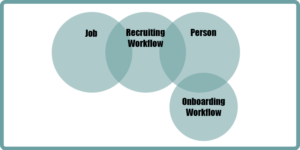If you’re new to iCIMS, the admin interface can feel like a game of “choose your own adventure”—except you don’t know what half the buttons do yet.
One of the first quirks worth wrapping your head around? FieldIDs.
They may not sound thrilling, but understanding how FieldIDs work is key to keeping your system clean, your integrations stable, and your sanity intact.
This guide breaks down what FieldIDs are, why they matter, and how they impact everything from workflows to reporting. And yes—this connects directly to your long-term iCIMS ROI.
Let’s start with the basics.
What’s a FieldID, Really?
In iCIMS, every profile (Person, Job, Recruiting Workflow, Onboarding) is made up of fields. These fields hold specific types of data like text, numbers, or dropdown selections.
But here’s the twist: field names are just labels. You can name multiple fields “Location,” and the platform won’t stop you.
What actually matters behind the scenes is the FieldID—a system-generated, permanent identifier assigned when the field is created. It’s a letter/number combo that never changes, even if the field’s display name does.
This is what iCIMS (and any integrations connected to it) uses to identify the field. Not the label. The ID. That means when you rename a field from “Department” to “Business Unit,” you won’t break any workflows or exports because iCIMS is still referencing the FieldID in your configuration.
This is especially important if you’re managing integrations, external reporting, or custom workflows. Trust us: FieldID fluency saves hours of guesswork.
Where the Data Actually Lives
Behind every profile in iCIMS is a data table. Each table stores the values entered into the fields on that profile.
Some tables overlap. For example, the Recruiting Workflow profile overlaps with the Person and Job profiles. That’s why you can access candidate and job data together in searches or reporting.
But not all profiles play nicely. A common sticking point? Onboarding profiles can’t access Recruiting Workflow data because they don’t share a table.
This kind of limitation often shows up mid-implementation or during post-launch configuration. If you’re hitting a wall trying to pull data across profiles, it’s worth connecting with an iCIMS consultant to explore options. There are often creative workarounds.
Why This Matters for System Health (and Your Job)
If you’re the person managing configuration or integrations, you’re probably juggling a dozen other priorities. So it’s tempting to let messy field naming slide. But over time, that mess compounds.
You end up with multiple fields doing the same thing under different names, redundant dropdowns, inconsistent search results—and a system no one trusts.
Clean Field names and smart architecture are what make the rest of your system work. They’re the difference between a reliable integration and one that fails silently. Between a report that works across departments and one that needs “manual cleanup” every time.
If your system feels bloated, confusing, or brittle, your field structure is a good place to start. Getting it right from the beginning—or investing in a cleanup through iCIMS consulting services—can pay off fast, especially when your team starts depending on reliable reporting and automation.
What We Recommend
- Document FieldIDs from the start. You don’t need to memorize them, but make sure your team knows how to find and track them.
- Avoid duplicate field labels. Just because you can name five fields “Status” doesn’t mean you should.
- Audit regularly. Especially after implementations or vendor-led builds.
- Ask for help. This is one of those areas where working with an experienced iCIMS consultant can save serious time—and prevent rework later.
There’s a lot you can solve in-house. But for long-term scaling and clean architecture, you don’t have to go it alone.
Want more insights like these?
FAQ
What is a FieldID in iCIMS?
A FieldID is a unique, system-generated identifier for a field in iCIMS. It doesn’t change—even if the field label does—and is used in workflows, integrations, and exports.
Can I have fields with the same name?
Technically, yes. But it’s not recommended. FieldIDs will still differentiate them, but using the same label can create confusion and mistakes.
Why does my onboarding profile not see recruiting workflow fields?
Because those profiles don’t share a data table.
How do FieldIDs affect integrations?
Integrations rely on FieldIDs—not field names—to pull and sync data. Renaming a field is safe. Changing or removing a FieldID breaks things.
What’s the ROI of cleaning up FieldIDs?
Cleaner fields = fewer errors, faster reporting, and stronger integrations. It’s foundational for long-term iCIMS ROI.




